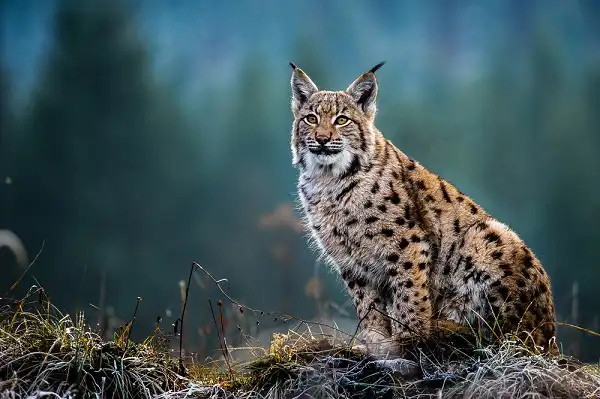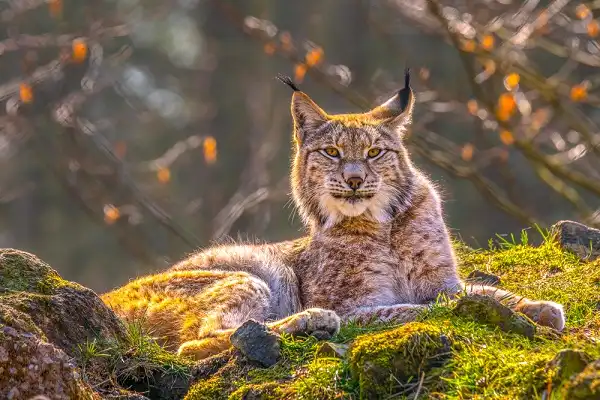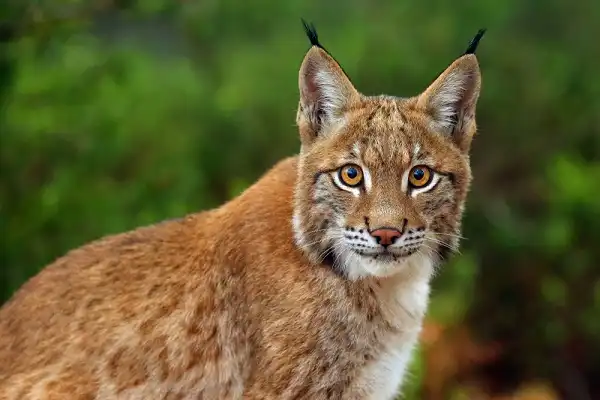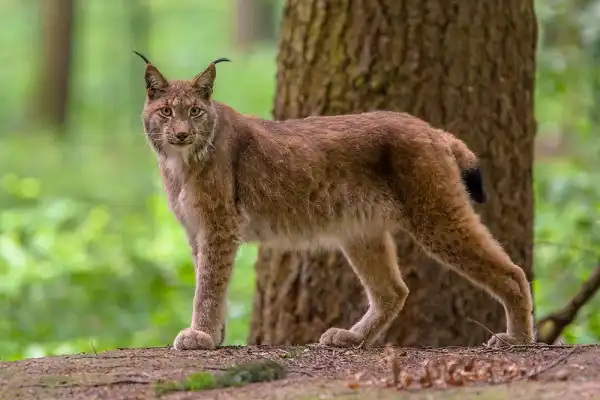If you’re a wild animal enthusiast, you’ve no doubt heard of lynx; the beautiful medium-sized feline known for its striking coat and short bobbed tail. Native to North America and Eurasia, this cat has captivated humans since ancient times due to its elegance in movement and the secretiveness of its whereabouts. Whether it’s the Canadian Lynx or the Eurasian Lynx that fascinates your interest, both species offer incredible insight into understanding these untamed cats against their natural habitats. Come learn more about these majestic animals from their unique physical features to behavior traits – one thing is certain: lynx will have you enchanted!

Lynx Description
The lynx is a beautiful wild cat species that is found across North America and Eurasia. It has an unmistakably striking coat of thick fur, ranging in colors from grey-brown to beige; its fur often displays black spots and stripes. Its most distinguishing feature is its short bobtail. The lynx also has large, furry paws with retractable claws for climbing trees, and unique tufted ears that provide excellent hearing capabilities. Aside from their physical features, these cats are also incredibly agile hunters, using their exceptional climbing abilities to ambush prey.
Lynx Habitat
Lynx are typically found in North American and Eurasian woodlands, as well as mountainous regions. They prefer dense forests with plenty of cover to hide away in and seek out areas with ample food sources such as small mammals, birds, and fish. In colder climates, they may inhabit snow-covered areas where the deep snow provides additional insulation from the frigid temperatures – allowing them to successfully hunt for food. These cats select den sites based on their availability of secure hiding locations as well as a good source of food. Although lynx rarely make nests, they will curl up in rock crevices or hollow trees to keep warm during cold weather. As adaptable animals, lynx have been known to survive – even thrive – in man-made environments such as suburban backyards or parks when wild habitats decline.
Lynx Diet
The lynx diet consists mainly of small mammals, such as rabbits, hares, mice, voles, and squirrels. They are opportunistic feeders and will also hunt birds and fish when available. Lynx have excellent senses of smell and hearing which they use to pinpoint prey while hunting at night. They will stalk their prey until the opportunity arises to pounce on them from a hidden location. In colder climates, lynx may also take advantage of snow-covered areas to hunt burrowing small mammals that are hiding away from the cold weather. Despite being solitary hunters, lynx can create a cooperative effort by working in groups or pairs when stalking larger prey such as deer or elk. In addition to hunting small game, they will sometimes scavenge carrion (dead animals) for food in areas with limited prey availability.

Lynx Size
The Lynx is a medium-sized wild cat species that typically range in size from 26 to 40 inches long, with a shoulder height of between 16 and 24 inches. On average, the Lynx can weigh up to 40 pounds, with males being larger than females. The lynx has a short bobbed tail that can range from two to four inches long which helps identify it easily from other cats. The lynx has large, furry paws with retractable claws for climbing trees and leaping onto prey, while its tufted ears help provide excellent hearing capabilities. Its dense fur coat helps to keep them insulated during cold winter months and comes in colors ranging from grey-brown to beige; often displaying black spots and stripes.
Lynx Lifespan
The Lynx is a medium-sized wild cat species with an average lifespan of 8 to 10 years in the wild. However, in captivity, they can live up to 15 years. Their life expectancy is determined by their environment and diet. In areas with adequate food sources and clean water, lynx can have a much longer lifespan than those living in harsh climates or environments with limited resources. The lynx’s natural predators include larger carnivores such as bears and wolves, although humans are the primary cause of death in many cases due to hunting and trapping activity. Lynx are also vulnerable to diseases, parasites, and accidents that can shorten their lifespan significantly.
Lynx Behavior
Lynx are shy and solitary creatures that exhibit bold and aggressive behavior when threatened. While hunting for food, lynx use their acute senses of hearing and smell to locate prey. In colder climates, they may take advantage of snow-covered areas to hunt burrowing small mammals that are hidden away from the cold weather. Aside from hunting for food, lynx will also engage in territorial marking behavior by leaving droppings or claw marks near their territory’s borders.
When content, lynx will purr but can hiss aggressively if threatened. To protect themselves from predators or other dangers in the wild, lynx are incredibly agile climbers and often find secure hiding locations within rocky crevices or hollow trees during the winter months. Despite being elusive creatures by nature, these cats can learn to adapt to human activity in suburban backyards or parks when wild habitats decline; allowing them to thrive even if food sources become limited.

Lynx Speed
The speed of the Lynx is highly impressive, with the cat able to reach speeds of up to 30 miles per hour when chasing prey. This incredible acceleration and agility allow the lynx to quickly ambush its prey from unexpected angles and with surprise attacks. In addition to running fast, the lynx can also perform high jumps in order to catch birds or other airborne prey. In one study, a single lynx was observed jumping up more than 6 feet in order to capture a grouse! Furthermore, they are able to climb trees rapidly in pursuit of their meals, making them a force to be reckoned with. When it comes to hunting away from their territory, lynx are capable of covering significantly large distances at an impressively quick pace. Not only are they able to cover miles upon miles in search of food but are also able to take multiple breaks along the way in order to conserve energy for the hunt.
Lynx Hunting
Lynx hunting is a very strategic effort. They use their acute senses of hearing and smell to locate prey, as well as their exceptional climbing abilities to ambush unsuspecting animals. Lynx are solitary hunters, but can also work in groups or pairs when stalking larger prey such as deer or elk. In addition to small mammals like rabbits, mice, hares, birds, and fish – they will sometimes scavenge carrion (dead animals) for food in areas with limited prey availability. Their agility helps them perform high jumps in pursuit of airborne prey and enables them to climb trees rapidly in search of meals. Furthermore, they can cover large distances quickly while taking multiple breaks along the way in order to conserve energy for the hunt.
Lynx Species
The Lynx is a wild cat species found across the northern regions of Europe, Asia, and North America. The four recognized species within the genus are the Eurasian lynx (Lynx lynx), Spanish lynx (Lynx pardinus), Canadian lynx (Lynx canadensis) and North American bobcat (Lynx rufus). Each species varies in size, coat coloration, and markings, as well as vocalization. The Eurasian or Northern Lynx is the largest of all four species, weighing up to 24 kg (53 lbs) with an overall body length ranging from 80–130 cm (31–51 in). They have thick grey-brown fur with black spots and stripes, long tufted ears, and a black-tipped tail.
The Spanish or Iberian Lynx is much smaller at around 12 kg (26 lbs) with an overall body length ranging from 60–75 cm (23–30 in). It has a light sandy-colored coat with reddish-brown markings on its underside, long tufted ears, and a short tail. The Canadian Lynx weighs around 15 kg (33 lbs) with an overall body length ranging from 65–95 cm (25–37 in). It has soft grey-brown fur with white patches on its chest and legs, short tufted ears, and a black-tipped tail. Lastly, the North American Bobcat weighs up to 16 kg (35 lbs) with an overall body length ranging from 55–100 cm (21–39 in). It has a sandy brown or grayish coat with white patches on its undersides, short rounded ears, and a short bobbed tail.

Conclusion
The Lynx is a wild cat species found across Europe, Asia, and North America. These cats use their acute senses of hearing and smell to locate prey, as well as their exceptional climbing abilities to ambush unsuspecting animals. The speed of the lynx is highly impressive. In addition, they are capable of covering large distances quickly while taking multiple breaks along the way in order to conserve energy for the hunt.
Frequently Asked Question

